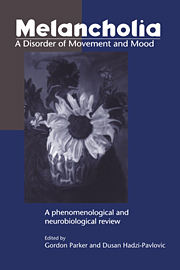Book contents
- Frontmatter
- Contents
- List of contributors
- Acknowledgments
- Introduction
- Part One Classification and Research: Historical and Theoretical Aspects
- Part Two Development and Validation of a Measure of Psychomotor Retardation as a Marker of Melancholia
- 5 Psychomotor Change as a Feature of Depressive Disorders: Historical Overview and Current Assessment Strategies
- 6 Development and Structure of the CORE System
- 7 Reliability of the CORE Measure
- 8 Validity of the CORE: I. A Neuroendocrinological Strategy
- 9 Validity of the CORE: II. Neuropsychological Tests
- 10 Validity of the CORE: III. Outcome and Treatment Prediction
- 11 Phenotypic Expression of Melancholia Contrasted for Those with Bipolar and Unipolar Illness Courses
- 12 Psychotic Depression: Clinical Definition, Status and the Relevance of Psychomotor Disturbance to Its Definition
- 13 A Clinical Algorithm for Defining Melancholia: Comparison with Other Sub-typing Measures
- 14 Rating the CORE: A User's Guide
- Part Three The Neurobiology of Melancholia
- The CORE Measure: Procedural Recommendations and Rating Guidelines
- References
- Author Index
- Subject Index
6 - Development and Structure of the CORE System
from Part Two - Development and Validation of a Measure of Psychomotor Retardation as a Marker of Melancholia
Published online by Cambridge University Press: 04 August 2010
- Frontmatter
- Contents
- List of contributors
- Acknowledgments
- Introduction
- Part One Classification and Research: Historical and Theoretical Aspects
- Part Two Development and Validation of a Measure of Psychomotor Retardation as a Marker of Melancholia
- 5 Psychomotor Change as a Feature of Depressive Disorders: Historical Overview and Current Assessment Strategies
- 6 Development and Structure of the CORE System
- 7 Reliability of the CORE Measure
- 8 Validity of the CORE: I. A Neuroendocrinological Strategy
- 9 Validity of the CORE: II. Neuropsychological Tests
- 10 Validity of the CORE: III. Outcome and Treatment Prediction
- 11 Phenotypic Expression of Melancholia Contrasted for Those with Bipolar and Unipolar Illness Courses
- 12 Psychotic Depression: Clinical Definition, Status and the Relevance of Psychomotor Disturbance to Its Definition
- 13 A Clinical Algorithm for Defining Melancholia: Comparison with Other Sub-typing Measures
- 14 Rating the CORE: A User's Guide
- Part Three The Neurobiology of Melancholia
- The CORE Measure: Procedural Recommendations and Rating Guidelines
- References
- Author Index
- Subject Index
Summary
Endogenous depression, perhaps renamed, appears to be a useful concept for both clinical and research purposes. It should be distinguished from non-endogenous depression.
(Andreasen, Grove and Maurer 1980)Most psychiatric disorders are classified largely on the basis of their clinical symptoms, or to be precise, a combination of the symptoms the patient complains of and the behavioural abnormalities evident on examination.
(Kendell 1983)Introduction
Our University School of Psychiatry has had a lengthy investment in the classification of depression, with the binary view favoured. The foundation professor, Leslie Kiloh, had undertaken a number of classic studies (e.g., Kiloh and Garside 1963) at Newcastle-on-Tyne, which made a strong argument that “endogenous” and “neurotic” depression are independent entities. After moving to Sydney, he designed a replication study (e.g., Kiloh et al. 1971), and follow-up of the cohort continues even now (e.g., Andrews et al. 1990a). The orientation of the dsm-iii classification (American Psychiatric Association 1980) to a more dimensional view of the affective disorders was of concern to us as we judged that the clinical and research utility in defining melancholia (or endogenous depression) risked being lost, and we sought to address that potential lost cause as our highest priority in setting initial objectives for our Mood Disorders Unit (MDU). Such indigenous concerns were later shared by North American researchers, with Zimmerman, Black and Coryell (1989) noting that the dsm-iii melancholia criteria had needed to be revised for two primary reasons: first, because the criteria “did not predict treatment response”; secondly, because “research suggested that the criteria did not identify a qualitatively distinct depressive subtype, but instead differentiated patients solely along a severity dimension.”
- Type
- Chapter
- Information
- Melancholia: A Disorder of Movement and MoodA Phenomenological and Neurobiological Review, pp. 82 - 129Publisher: Cambridge University PressPrint publication year: 1996
- 16
- Cited by

